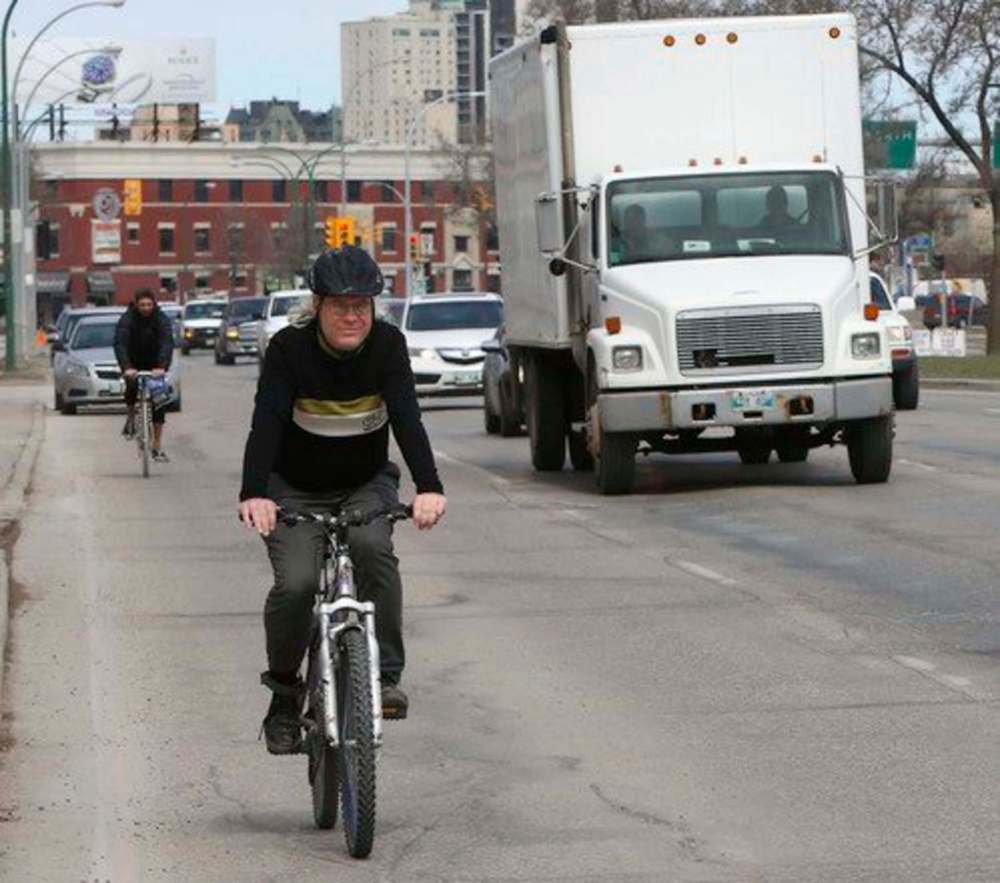Number of locals commuting by bike backpedals: report
Advertisement
Read this article for free:
or
Already have an account? Log in here »
To continue reading, please subscribe:
Monthly Digital Subscription
$0 for the first 4 weeks*
- Enjoy unlimited reading on winnipegfreepress.com
- Read the E-Edition, our digital replica newspaper
- Access News Break, our award-winning app
- Play interactive puzzles
*No charge for 4 weeks then price increases to the regular rate of $19.00 plus GST every four weeks. Offer available to new and qualified returning subscribers only. Cancel any time.
Monthly Digital Subscription
$4.75/week*
- Enjoy unlimited reading on winnipegfreepress.com
- Read the E-Edition, our digital replica newspaper
- Access News Break, our award-winning app
- Play interactive puzzles
*Billed as $19 plus GST every four weeks. Cancel any time.
To continue reading, please subscribe:
Add Free Press access to your Brandon Sun subscription for only an additional
$1 for the first 4 weeks*
*Your next subscription payment will increase by $1.00 and you will be charged $16.99 plus GST for four weeks. After four weeks, your payment will increase to $23.99 plus GST every four weeks.
Read unlimited articles for free today:
or
Already have an account? Log in here »
Hey there, time traveller!
This article was published 29/05/2019 (2366 days ago), so information in it may no longer be current.
Winnipeg leads the country in the number of commuters putting a key in the ignition instead of a shoe on a bike pedal when their trip is five kilometres or less to the downtown, according to new data from Statistics Canada.
The Manitoba capital also has the lowest proportion of commuters living and working in the city’s core walking or cycling to work, with only about one in five doing so.
The report compiled by Statistics Canada released Wednesday is based on information gathered during the 2016 census and in comparing much of it to information received during the 1996 census.

The report, entitled Commuting Within Canada’s Largest Cities, took a look at the commuting patterns of people in the country’s eight largest metropolitan areas, including Winnipeg, Toronto, Montreal, Vancouver, Calgary and Edmonton.
Almost 72 per cent of Winnipeggers who live within five km of the downtown use a car, truck or van to get to work each day, compared to 25 per cent in Toronto, 63 per cent in Calgary, and 57 per cent in Ottawa.
The report found every major city across the country has more people who live and work in the core area walking or bicycling to work each day. However, Winnipeg lags behind in its increase.
Toronto has reported a jump to 47.4 per cent of commuters in 2016 from 19.3 per cent in 1996, and, during the same time period, Montreal went to 38 per cent from 16 per cent and Calgary to 38 per cent from 15 per cent. Winnipeg’s totals rose only slightly: to 19.9 per cent, from 13.2 per cent.
In a trend seen in several cities across the country, the number of people walking and cycling in a traditional commute from outside to inside the core, and commuting from one area of the suburbs to another, has dropped. In Winnipeg, it slid to 1.6 per cent in 2016 from 1.9 per cent in 1996 for the former, and to 12.1 per cent from 16 per cent for the latter.
Despite this, Mark Cohoe of Bike Winnipeg sees good news in the report: in 2016, there are more commuters cycling and walking from the downtown to jobs elsewhere (3.7 per cent) than commuting the other way (1.6 per cent).
“If you’re living downtown, you might have already made the decision to go to areas by bike,” Cohoe said. “You might be more willing to ride (a) bike.”
Cohoe said the main difference between Winnipeg and several other cities is the others invested earlier in active transportation, including bicycle paths.
Noting the report from Statistics Canada appears to come out every 20 years, Cohoe is hoping for better in 2036.
“I’d definitely be hoping there is a substantial increase,” he said. “I’d like to get to 40 per cent cycling within the core and 12 per cent commuting to the downtown.
“We’ve seen it in other centres. We need to build the infrastructure.”
kevin.rollason@freepress.mb.ca

Kevin Rollason is a general assignment reporter at the Free Press. He graduated from Western University with a Masters of Journalism in 1985 and worked at the Winnipeg Sun until 1988, when he joined the Free Press. He has served as the Free Press’s city hall and law courts reporter and has won several awards, including a National Newspaper Award. Read more about Kevin.
Every piece of reporting Kevin produces is reviewed by an editing team before it is posted online or published in print — part of the Free Press‘s tradition, since 1872, of producing reliable independent journalism. Read more about Free Press’s history and mandate, and learn how our newsroom operates.
Our newsroom depends on a growing audience of readers to power our journalism. If you are not a paid reader, please consider becoming a subscriber.
Our newsroom depends on its audience of readers to power our journalism. Thank you for your support.


